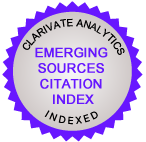The imaginary of algorithmic narratives
-
Daniel Horacio Cabrera Altieri
 danhcab@yahoo.es
danhcab@yahoo.es
-
María Angulo Egea
 mangulo@unizar.es
mangulo@unizar.es
Downloads
DOI:
https://doi.org/10.4067/S0718-48672020000100013Abstract
Journalistic and marketing narratives invoke "algorithms" as a key to the relationship between people, technology, and politics. Sometimes exploring possibilities, sometimes trying to explain them, and still others as a cause for alarm for freedom and security. Algorithms are responsible because, as they say, "algorithms know everything"; therefore, "how to deceive the algorithm" strategies are promoted.
In this article, an approach is made to the algorithm from the modern imaginary of the machine, the numeration, and the calculability to then analyze the function of the software as a central element of the current culture. Interpreted from the imaginary, the algorithm is revealed as a central cultural element to which it seems that the user can only approach from the magical.
Palabras Clave
ANGULO, M. (2017): Inmersiones. Crónica de viajes y periodismo encubierto. Barcelona: Universitat de Barcelona.
BERNERS-LEE, T. (2000): Tejiendo la red. Madrid: Siglo XXI.
BERRY, D. M. y PAWLIK, J. (2008): What is code? A conversation with Deleuze, Guattari and Code, en BERRY, D. M. y MOSS, G., Libre Culture. Meditations on Free Culture. Winnipeg: Pygmalion Internet Archive, pp. 56-68.
CABRERA, D. H. (2006): Lo tecnológico y lo imaginarios. Las nuevas tecnologías como creencias y esperanzas colectivas. Buenos Aires: Biblos.
CARDÓN, D. (2018): Con qué sueñan los algoritmos. Nuestras vidas en el tiempo de los big data. Madrid: Dado.
CASTELLS, M. (2000): La era de la información: economía, sociedad y cultura. Vol. I. La sociedad red, Madrid: Alianza.
CASTORIADIS, C. (1993): La institución imaginaria de la sociedad. Barcelona: Tusquet.
CHUN, W. H. K. (2011): Programmed Visions: Software and Memory. Cambridge, Mass: The MIT Press.
DAVIS, M. (2002): La computadora universal. De Leibniz a Turing. Barcelona: Debate.
DELEUZE, G. (2006): Post-scriptum sobre las sociedades de control. Polis, n.13. Disponible en: http://journals.openedition.org/polis/5509 doi:10.1017/S147924431600024X
DIJCK, J. (2016): La cultura de la conectividad. Una historia critica de las redes sociales. Buenos Aires: Siglo XXI.
FINN, E. (2018): La búsqueda del algoritmo. Imaginación en la era de la informática. Barcelona: Alpha Decay.
FOUCAULT, M. (1988): El sujeto y el poder. Revista Mexicana de Sociología, 50 (3), pp. 3-20.
GLEICK, J. (2012): La información. Historia y realidad. Barcelona: Crítica.
GUREVICH, A. (2018): La vida digital. Intersubjetividad en tiempos de plataformas sociales. Buenos Aires: Crujia.
HILL, R. K. (2016): What an Algorithm Is? Philosophy and Technology, no. 29 pp. 35-59. DOI 10.1007/s13347-014-0184-5
KANG, M. (2017): The mechanical daughter of Rene Descartes: the origin and history of an intellectual fable. Modern Intellectual History, 14 (3), pp. 633-660.
LAVAL, C.; y DARDOT, P. (2015): La nueva razón del mundo. Ensayo sobre la sociedad neoliberal. Barcelona: Gedisa.
LIZCANO, E. (1993): Imaginario colectivo y creación matemática. Barcelona: Gedisa.
MANOVICH, L. (2013): El software toma el mando. Barcelona: UOCpress.
MATTELART, A. (1995): La invención de la comunicación. Madrid: Bosch.
____ (2000): Historia de la utopía planetaria. De la ciudad profética a la sociedad global. Barcelona: Paidos.
MONASTERIO, A. (2017): Ética algorítmica: Implicaciones éticas de una sociedad cada vez más gobernada por algoritmos. Dilemata, Revista Internacional de Éticas Aplicadas, 9 (24), pp. 185-217.
O´NEIL, C (2017): Armas de destrucción matemática. Cómo el big data aumenta la desigualdad y amenaza la democracia. Madrid: Capitán Swing.
SADIN, É. (2018): La siliconización del mundo, La irresistible expansión del liberalismo digital. Buenos Aires: Caja Negra.
SIBILA, P. (2009): La intimidad como espectáculo. Buenos Aires: Fondo de Cultura Económica.
SRNICEK, N. (2018): Capitalismo de plataformas. Buenos Aires: Caja Negra.
VON NEUMANN, J. (1999): El ordenador y el cerebro. Zaragoza: Antoni Bosch.
WEIZENBAUM, J. (1978): La frontera entre el ordenador y la mente. Madrid: PiraÌmide.
Most read articles by the same author(s)
- Daniel Horacio Cabrera Altieri, Communication as contagion. Social imaginary, metaphor and communicology. , Perspectivas de la Comunicación: Vol. 16 No. 2 (2023): July - December
- María Angulo Egea, Construction of the discourse on the crisis: the evicted people. Analysis of reports and biographical sketches (2012-2015) , Perspectivas de la Comunicación: Vol. 11 No. 1 (2018): january - august
- María Angulo Egea, Siete picas. Entre la ciencia y el periodismo. , Perspectivas de la Comunicación: Vol. 10 No. 1 (2017): Enero - Agosto
- Daniel Horacio Cabrera Altieri, Technologies, imaginaries and new narratives , Perspectivas de la Comunicación: Vol. 13 No. 1 (2020): January - June
Similar Articles
- Baal Ulises Delupi, Carnival, all my life! Artivistic Resistance Speeches in Barcelona: The Case of Enmedio , Perspectivas de la Comunicación: Vol. 15 No. 1 (2022): January - June
- Daniel Horacio Cabrera Altieri, Communication as contagion. Social imaginary, metaphor and communicology. , Perspectivas de la Comunicación: Vol. 16 No. 2 (2023): July - December
- Esteban Torres, The intercommunication system: from media to world social change , Perspectivas de la Comunicación: Vol. 16 No. 1 (2023): January - June
- Alfredo Arceo Vacas, Rafael Barberá González, Sergio Álvarez Sánchez, The context of perception generated on Twitter for the Spanish electoral debates of December 2015 and June 2016: treatment of the credibility factors by the candidates , Perspectivas de la Comunicación: Vol. 13 No. 2 (2020): July-December
- Yolanda García-Ochoa Cabrera, Doctora, Vanessa Roger Monzó, Doctora, Construction of the social imaginary of alternative therapies through discourse in social networks: case study of the channel “Alternative therapies and natural remedies” , Perspectivas de la Comunicación: Vol. 12 No. 1 (2019): January - June
- Eugenia Blasetti, Emma Garzonio, The social representation of migrants during the COVID-19 pandemic. An Italian case study on hostile narratives and visual political communication , Perspectivas de la Comunicación: Vol. 15 No. 2 (2022): July - December
- Giovanna Gianturco, Francesca Colella, Identity, otherness, interculture: conceptual orientations between stereotypes and social imaginary , Perspectivas de la Comunicación: Vol. 15 No. 2 (2022): July - December
- Bianca Racioppe, Julieta Párraga, Memes on Instagram: a case study of accounts dedicated to the production and circulation of these contemporary narratives , Perspectivas de la Comunicación: Vol. 13 No. 1 (2020): January - June
- Pablo Matus, Magdalena Vitores, Claudia Ramírez Friderichsen, Generic frames on the front covers of the Chilean press related to the social outbreak of 2019 , Perspectivas de la Comunicación: Vol. 17 (2024): January - December
- Francisco Sierra Caballero, Salomé Sola-Morales, Oppositional public space and cyberactivism, a materialistic reading of connective action , Perspectivas de la Comunicación: Vol. 13 No. 2 (2020): July-December
1 2 3 4 5 6 7 8 9 10 11 12 > >>
You may also start an advanced similarity search for this article.
Downloads
Published
How to Cite
Issue
Section
License
Copyright (c) 2020 Perspectivas de la Comunicación - ISSN 0718-4867

This work is licensed under a Creative Commons Attribution 4.0 International License.
- Proposed policy to offer Open Access Journals
Authors who publish with this journal agree to the following terms:
a) Authors retain copyright and grant the journal right of first publication with the work simultaneously licensed under a Creative Commons Attribution Attribution (CC -BY 4.0) ![]() that allows others to share the work with an acknowledgement of the work's authorship and initial publication in this journal.
that allows others to share the work with an acknowledgement of the work's authorship and initial publication in this journal.
b) Authors are able to adopt licensing agreements for the non-exclusive distribution of the journal's published version of the work (for example, to post it to an institutional repositories or publish it in a monograph), with an acknowledgement of its initial publication in this journal.
c) Authors are allowed and encouraged to post their work online (For example, in institutional repositories or on their website) prior to and during the submission process, as it can lead to productive exchanges and increase the citation of published work (See The Effect of Open Access).











